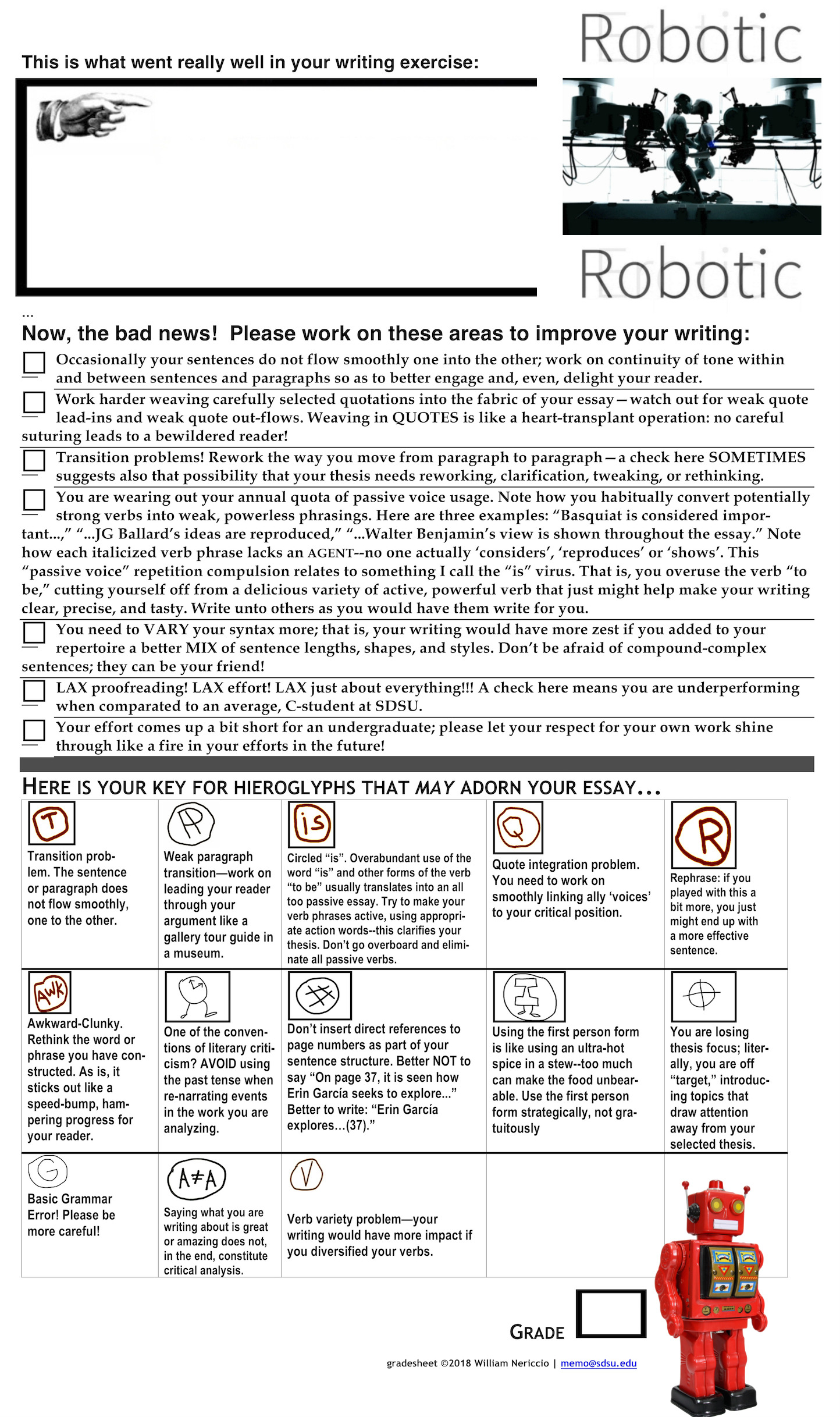ENGLISH 220 ROBOTIC EROTIC ELECTRICTHE IMAGINATION CHALLENGE**aka, your major essay of the semester! |
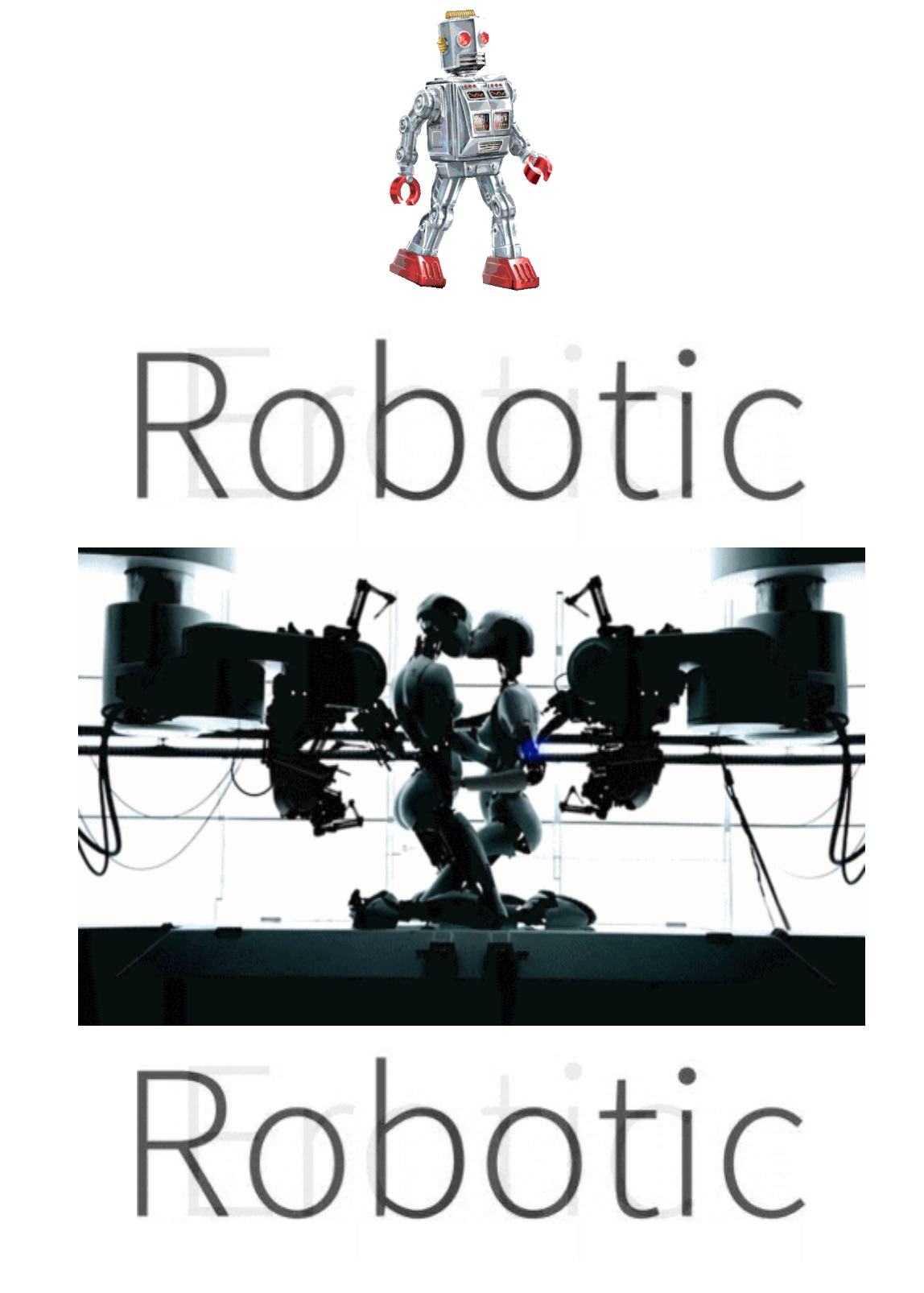
Lastly,
please use
MLA or University
of Chicago works cited style pages to guide your
formatting. Your robotic erotic electric expository
bundles of genius are due Friday,
November 16 @ 12 noon--you will come to my office
and drop your paper into the appropriate bags at
the front of my office door, AL 273, Arts and
Letters 273; these bags correspond to your
specific robotic erotic electric team
(there will be one other bag with my name on it as
well for those who want to brave the choppy waters
of my grading!). Late
papers
will not be accepted. Early papers, in most cases,
will be cherished lovingly. All
"A-grade" level "imagination challenge" essays will
integrate select, direct quotations from the primary
texts read thus far in the class this semester and
will avoid ALL of the quicksand-like bad habits listed
on the gradesheet
already mentioned above.
Additionally, A-level grades will be awarded ONLY
to crafty undergraduates who make use of scholarly
research discovered either by prowling "the stacks"
(the shelves and shelves of books that fill Love
Library, aka the "Library
of Love") or that you can gather off of JSTOR or PROJECT
MUSE--be sure to CITE THESE WORKS CAREFULLY. In
general, avoid research garnered from the
internet--any use or adaptation of material from Spark
Notes, Cliffs Notes, Barron's Notes, etc (and
especially essays that rely on Wikipedia) will likely
be returned to you ungraded or burned ritually at a
secret sacred site guarded by literary druids! One last
bit of advice, do NOT plagiarize ANY material from an
online source or 'paper mill.' In other words: unCITED material = PLAGIARISM;
also, as noted above, if you are going to analyze a key
element from an illustrated or filmed work, do please go
to the bother of xeroxing the image and incorporating it
INTO your essay with captions and with a notation in the
'Works Cited' to let your readers know where you got it
from. Last hint? Have a blast with this paper! Try things you have NEVER tried before! Test the limits of your imagination! Good luck! This IMAGINATION CHALLENGE is slightly different from other writing assignments you may have completed as an undergraduate (for example, please leave everything you learned to loathe in RWS 100 or 200 at the door--unless your instructor was a genius, in which case, use your best judgment). For this Imagination Challenge you will fill in the blanks provided below and then complete the essay making sure to provide specific textual evidence to sustain/defend/illustrate your stated position in your writing! FINISH only ONE of the following challenges. Note that some of the blanks below are meant to be filled with authors' names whilst others should be filled with specific phrases/ideas; read the prompts carefully to make your final determination. One last thing. Try to finish your paper a DAY BEFORE it is due. Print it out and lay it on a desk in your room. A day later, wake up early and take this printed work and go to a room/library/cafe you don't usually go to--go there with a big old printed dictionary, you should own one and you can get good ones for cheap at old book stores like Maxwell's House of Books, DG Wills Books, Bluestocking Books, Verbatim Books, and other area book shops. Take your paper to this special place and edit your paper. We really don't have the power to carefully edit a document on the screen where it was composed. You must switch the medium, going from screen to paper, from photons to ink, to see errors your reader will trip over! Cool. Go for it! Here are your prompts! Unless you KNOW you can write a better introductory paragraph, please use these PromptParagraphs™ (an intellectually enhanced version of MadLibs!) as your actual opening paragraph for your paper. Option 1. HEGEMONIC SCREENS
DEPARTMENT During the course of this semester, we have encountered a number of works that are infected with screens. In Philip K. Dick’s Do Androids Dream of Electric Sheep, television screens act as a __________________ between the oppressive forces of Mercerism (i.e. God) and the downtrodden human and robotic organisms that remain on a post-apocalyptic earth. Similarly in Haruki Murakomi’s After Dark, various types of screens seem to aid in the idea of a ____________________ society. The moral of each tale relies heavily on the idea that screen (and the ___________________ they promote) have a ___________________ effect on society as a whole. Both novels have brought to my attention the way in which our contemporary society relies on and is infected by screens. Such connections that I’ve recognized include ____________________, ____________________ and _______________________. Throughout this essay I will expound on these theories of a likeness between the screens found in Do Androids Dream of Electric Sheep and After Dark and that of our contemporary gadget-obsessed culture. Option 2: Kafka, Crumb, and Mairowitz Go For a Walk With Nancy Oliver and Craig Gillespie Robert Crumb's mesmerizing artistic work splashes across the pages of Kafka written by David Mairowitz. Both Mairowitz's and Crumb's revelations with regard to Franz Kafka can be adapted to explore the work of other writers, artists, and directors. In the pages that follow, I will use both the words of Kafka (as adapted by Mairowitz) and the illustrations of Crumb to explore Lars and Real Girl, directed by Craig Gillespie with a screenlay by Nancy Oliver. By doing so, I hope to illustrate how _____________________... Option 3: White Women on the Verge... At first glance, Charlotte Perkins Gilman’s “The Yellow Wallpaper, ” Ira Levin’s The Stepford Wives, and Philip K. Dick's Do Androids Dream of Electric Sheep seem to have little to say to one another. They take place in wildly different times and places, and appear to be about extremely different subjects. But take a second look. After all, doesn't each book feature middle-class white women who, arguably, descend into “madness” or some sort of similar psychological disturbance? Each character’s madness is precipitated by many different factors and characterized in many different ways. "Jane"’s is _______________, ______________, and _______________; Joanna’s is ___________________, ____________________, and __________________; and Iran's is _______________, ________________, and ______________. Still, the similarities are undeniable. This essay will argue that, taken together, the texts point to ____________________, ______________________, and ________________________, which seem to be features of white, middle-class womanhood that have remained oddly stagnant over time. Option 4. Psychology &
Graphic Narrative (note that doing this
challenge means also doing some cool secondary
research on human psychology) A
provocative graphic narrative by Dan Clowes, The Death Ray challenges
its
readers to explore the _________________ and
___________________of human psychology--to be more
specific, Clowes take viewers/readers on a tour of
___________________ introducing characters and
situations that reveal ____________________. Recently,
specific scholars have written essays that shed new
light on these human psychological phenomena--typical
among these is "__________{essay title}_______________"
written by ____{scholar's
name}_________. However, I am not totally
content, with Professor _________________'s study. In
the paragraphs that follow, I will briefly illustrate my
problems with his/her work and suggest better ways to
explore the concept using Clowes's novel comic book to
guide my way. Option 5. Charlotte Perkins
Gilman, Frida Kahlo, Francesca Woodman and Haruki
Murakami, Fused! How is
it possible that an American short story writer from
the early 20th century, a Mexican painter from the
middle of the 20th century, an American photographer
from late 20th and a Japanese writer from the early
21st century can be seen to share a similar obsession?
And yet that is the case with Charlotte Perkins
Gilman, Frida Kahlo, Francesca
Woodman, and Haruki Murakami. In my brief
study that will unfold before you here, I will take
the time to focus on the themes of _____________ and
______________ as I weave a critical tale of Gilman's,
Kahlo's, Woodman's and Murakami's kinship. But I will
also take time below to point out their contrasts,
especially with regard to ________________________. Option 6. Comparative Literature:
Franz Kafka, Philip K. Dick and Haruki Murakami The best literature is merely a vehicle for surveilling the complex corridors of the human mind. With ___________{main character name}__________(from Metamorphosis, ___{main character name}_________ (from Do Androids Dream of Electric Sheep), and ______{main character name}______ (from After Dark) writers Franz Kafka, Philip K. Dick, and Haruki Murakami introduce readers to _______________________________. I will use the next few pages to creep carefully into the psyches of these three memorable characters from literature in order to explore how ___________________________. In order to add complexity to my comparative dissection of Kafka's, Dick's, and Murakami's achievements, I will incorporate a recent piece {after 2010} of literary criticism written by ________________ on _______________________ --this essay helps us probe the imaginative depth and psychological complexity of these threee memorable characters. Option 6. James Baldwin and Sigmund Freud, Reconsidered James
Baldwin does a remarkable job letting us get inside of
his head in "Notes of a Native Son" giving us a taste
of the black male psyche, in particular showing how
______________________________. Alternatively, Sigmund
Freud gives us a vocabulary and methodology to unpack
the complexity of this psyche in his essay
entitled "Delusion and Dream in Jensen's Gradiva"--in
particular, Freud's essay gives us new ways to
consider how ________________________________ factors
into the imagination of a writer. In the paragraphs
that follow, I will attempt to apply adaptations of
Freud's scribblings to Baldwin's essay. In particular,
I hope to explore how ______________________ ... Option 7. Allusions
Allusions Allusions... In the first four weeks of this class, we have been drowned in literary and cinematic works that are filled with allusions and while Professor Nericcio has been scrupulous in his tracking down many of these significant allusions, he just does not have the time in 75 minutes with 221 students to really explore the down and dirty nitty gritty of some of the more curious allusions we have run across so far. In the paragraphs that follow, I will try to document some of the more compelling literary allusions we have run across that our good Professor failed to focus on in class... Option 8 Brutal Misogyny This, then, will be an
essay-length meditation on misogyny as it unfolds in the
pages of Ira Levin's The
Stepford Wives and Haruki Murakami's After Dark. While
other themes dominated these heralded novels, it is in
their nuanced study of male violence against women that
they resonate in unison. In telling the story of
misogyny I will fold in two striking pieces of critical
analysis on the phenomenon written by ____________ and
by ________________. Adding these two works to our
analysis will help readers see _________________ and
__________________in Levin's and Murakami's
masterpieces. Option 9 Putting the Erotic
in Robotic Erotic Electric A provocative psychological film by writer Nancy Oliver and director Craig Gillespie, Lars and the Real Girl challenges its readers to explore the ______________________ of human sexuality--to be more specific, Oliver and Gillespie take viewers on a tour of ___________________ introducing characters that ______________________. Centuries earlier, Mary Shelley authored her Frankenstein: A Modern Prometheus which had us focus on _________________ when it came to sexuality. Recently, specific critics have focused on eroticism and sexuality in human psychology--typical among these is ________________ written by _____________. I am not totally content, however, with Professor ______________'s study of the psychology of sexuality in American cinema. In the paragraphs that follow, I will briefly illustrate my problems with his/her work and suggest better ways to explore Oliver and Gillespie's film and Shelley's novel. Option 10: Double Double In both "The Yellow Wallpaper" by Charlotte Perkins Gilman, and Ira Levin's The Stepford Wives, we encounter two variations on a similar situation: the main character is replaced with a double who looks identical on the outside, but whose interior metamorphosis is drastic and dramatic. These seemingly seamless transformations are both so moving and disturbing because ________________________. In this essay I will discuss the implications that the act of replication and replacement may have for their (and our) identities, but I will also focus on the key differences between the alterations these women undergo, such as ____________________ and ______________________. In particular, I will use a third work, Phillip K. Dick's masterpiece Do Androids Dream of Electric Sheep?, to elucidate these differences, comparing the robots in Levin's work with PKD's Replicants, and contrasting them with Gilman's "Women in the Walls." I hope to demonstrate that although each version of the "identical impostor" is unique, they each share certain key characteristics. Option 11: Tag Team Essay! Alex Garland vs Mary Shelley The conclusion of this essay appears here in the introduction: Alex Garland's Ex-Machina and Mary Shelley's Frankenstein, or The Modern Prometheus have nothing to do with each other. I know what you are thinking. "How can that be" or "this writer is crazy." After all, both works, the movie and the novel introduce us to future worlds where technology directly impacts upon the human animal. But I intend to argue something opposite. That when you look closer Garland and Shelley actually emerge as adversaries, as antagonists, and that the recent film and classic novel are better seen as ___________________. To tell this story, I will rely on recent cultural criticism by ___________________ to assist me in the weaving of my argument... Option 12: Artificial
Artificial In many of our
readings this semester we encounter, the protagonist
buys an artificial experience--for instance, Decker owns
a robotic sheep, Lars obtains an "anatomically correct
sex doll", and the husbands in Levin's Stepford novel
construct frighteningly submissive femme robots. But we
also meet androids and mannequins alike that yearns to
be "real." In these works, what is real and what is
artificial is muddled. Something we have touched upon in
class (but perhaps not by that name) is the simulacrum,
simply put, a representation or an imitation of a person
or a thing. On the subject of the simulacrum, the
Italian author Umberto Eco said: "we not only enjoy a
perfect imitation, we also enjoy the conviction that
imitation has reached its apex and afterwards reality
will always be inferior to it". Keeping this in mind,
how does this apply to the readings we have discussed in
class? Is buying an inauthentic / artificial experience
superior to the real experience, or is Eco wrong? How do
we determine what is "real" and what is "artificial"?
Can the "artificial" ever become "real"? Consider these
questions when you write an essay using either Do Androids Dream of
Electric Sheep? or Stepford Wives and pair it with Be Right Back (Black Mirror), Lars and the Real Girl,
or The After Hours
(the Twilight Zone). Your essay should incorporate
findings from the published work of Humberto Eco and
Jean Baudrillard on the concept of the "simulacram" or
"simulation." Your essay must incorporate secondary
research as in all the other questions/prompts if you
want to be considered for an A-level grade! Option 13: Music at the
Heart of a Novel In After Dark, Haruki Murakami frequently incorporates “diegetic” music into his scene descriptions. In this essay, I explore his incorporation of the following three songs: [song 1] by [artist], [song 2] by [artist], and [song 3] by [artist]. Having listened to the songs numerous times, I will both survey the composition [i.e. describe its aural mechanisms and articulate its emotional effect] and describe how this music supports, augments, and/or complements the dramatic tension of its corresponding scene. Having accomplished this, I will then articulate how [any existing recording] might be sutured into a scene from [another novel or story we read in class] by [author] in order to complement the dramatic events portrayed therein. As an antithesis, I will address problems that may arise from the inclusion of music in text. What happens if a composition is too obscure? What happens to readers who are confronted with limitless references to music they have never heard? Lastly, I will opine the aesthetics of “diegetic sound” in the novel (or short story) by answering the following question: When does diegetic sound succeed in a novel or short story? First note: Take time in this essay to clearly map out what is occurring in your selected scenes (4 total!) — make sure to write as though your reader has never read these novels. Consider things like, who are the characters? what is going on with them at this moment? what is the relationship between these characters? what is their relationship to their physical environment? — but, a warning, don’t consider this an exhaustive checklist! In a phrase, make sure to “set the scene” for the reader of your essay; help them understand the situation so that your discussion of music’s role makes sense to them. Second note: Diegetic
sound is any sound presented as though it is arisen from
within the fictional world. If you are watching a movie
and the characters are listening to the radio then it is
clear that we (audience) can hear the music, but it is
implied that the characters can hear the same music
simultaneously. This is diegetic sound. Similarly, if an
author tells us what song is playing inside a restaurant
or bar, this would constitute a “diegetic” sound. Finally — if you need
help with this question, email
daniel.austin.warren@gmail.com, i.e. Robot team
leader. Option 14. The themes of spiritual and corporeal metamorphosis, transformation, alchemy, and/or transubstantiation have been present in all the literature we’ve been exposed to so far. Looking at After Dark by Haruki Murakami, Frankenstein by Mary Shelly and Do Androids Dream of Electric Sheep by Philip K. Dick, write an essay that explores the different ways these artists express and confront this phenomena. Why are these depictions of transformation relevant to us? What makes them important to your understanding of both human actualization on a personal level, and world affairs on the larger socio-political level? Do the worlds described project utopian or dystopian realities? Feel free to bring in references from any of the films we’ve seen, insights from Dr. Nericcio’s work in cultural studies Tex[t] Mex, ancient mythology, philosophy, art, or graphic novels. Enter this chrysalis as a lowly worm, and exit as a butterfly. The sky is NO-Limit, enjoy! Option 15. Roll your own! Develop and refine your OWN
independent fill in the blanks prompt--it must make use
of at least two works from the required texts (books,
film, graphic narrative, etc) we have and will peruse
this term. You MUST bring your proposal to me, typed out
on paper by the beginning of class Thursday, November 8,
before OR after class, or email your proposal to me at
memo@sdsu.edu--no emailed proposals will be considered
after 12noon, Friday, November 9, 2018. You are
also welcome to run it by me in person during office
hours or by appointment. Have fun!
|
 Write unto others as
you would have them write for thee! Write unto others as
you would have them write for thee! |
| MODELS FOR GOOD
LITERARY AND FILM CRITICISM |
| If you have never read a good piece of literary
criticism or film theory, it is probably a good idea to
read some BEFORE you tackle this writing assignment; below
appear paragraphs and a link to some good writing focused
on literature and film. As you do your research for your
essay, pay attention not just to the ideas of the critics
you select to share in your essay as proof, pay attention
as well to the way they carefully craft these arguments. Edward Said, one of my stylistic mentors, on Joseph Conrad... 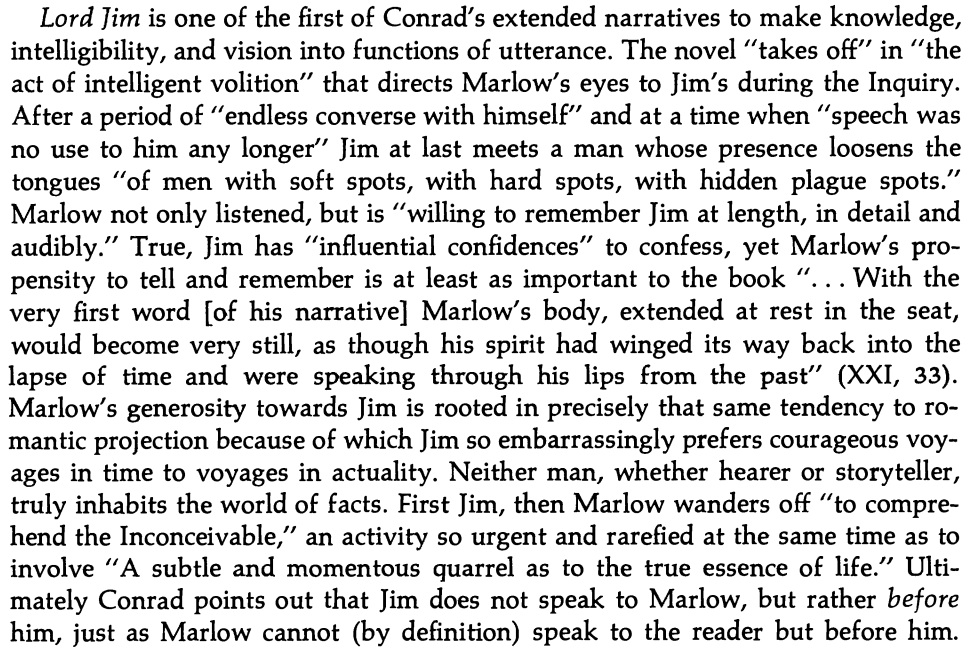 Edward Said, again, on Joseph Conrad (and Sigmund Freud)... 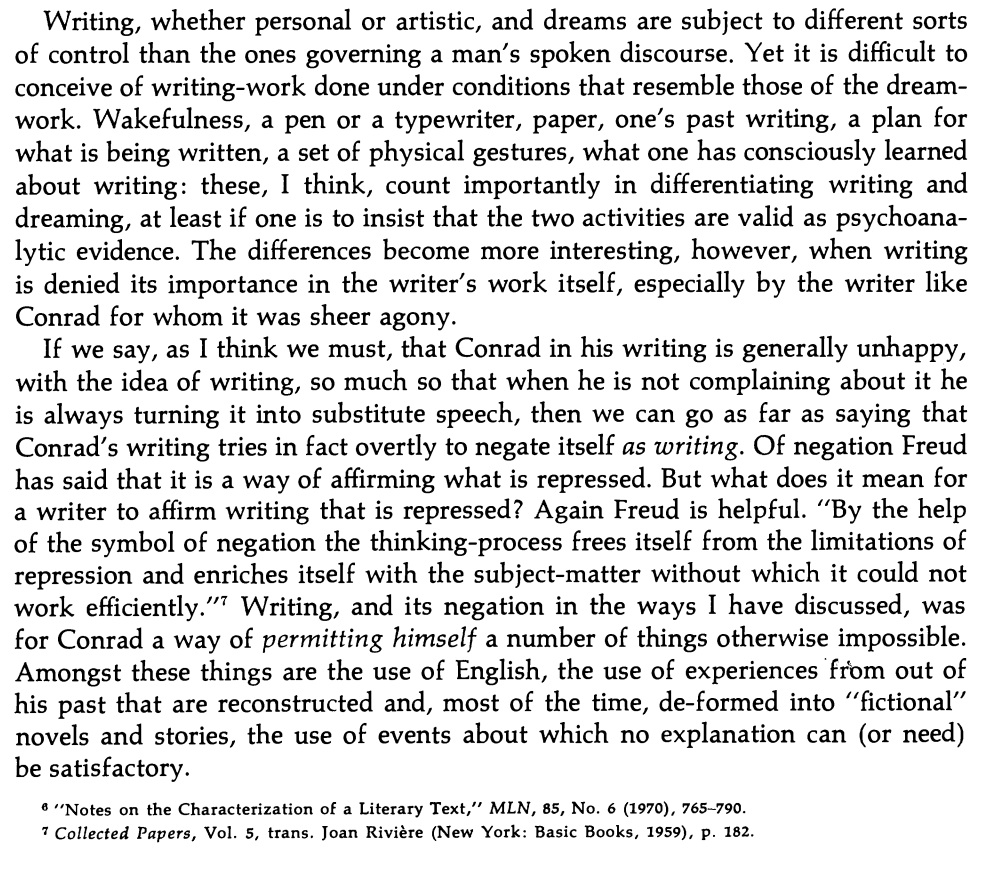 Helen Vendler on Criticism 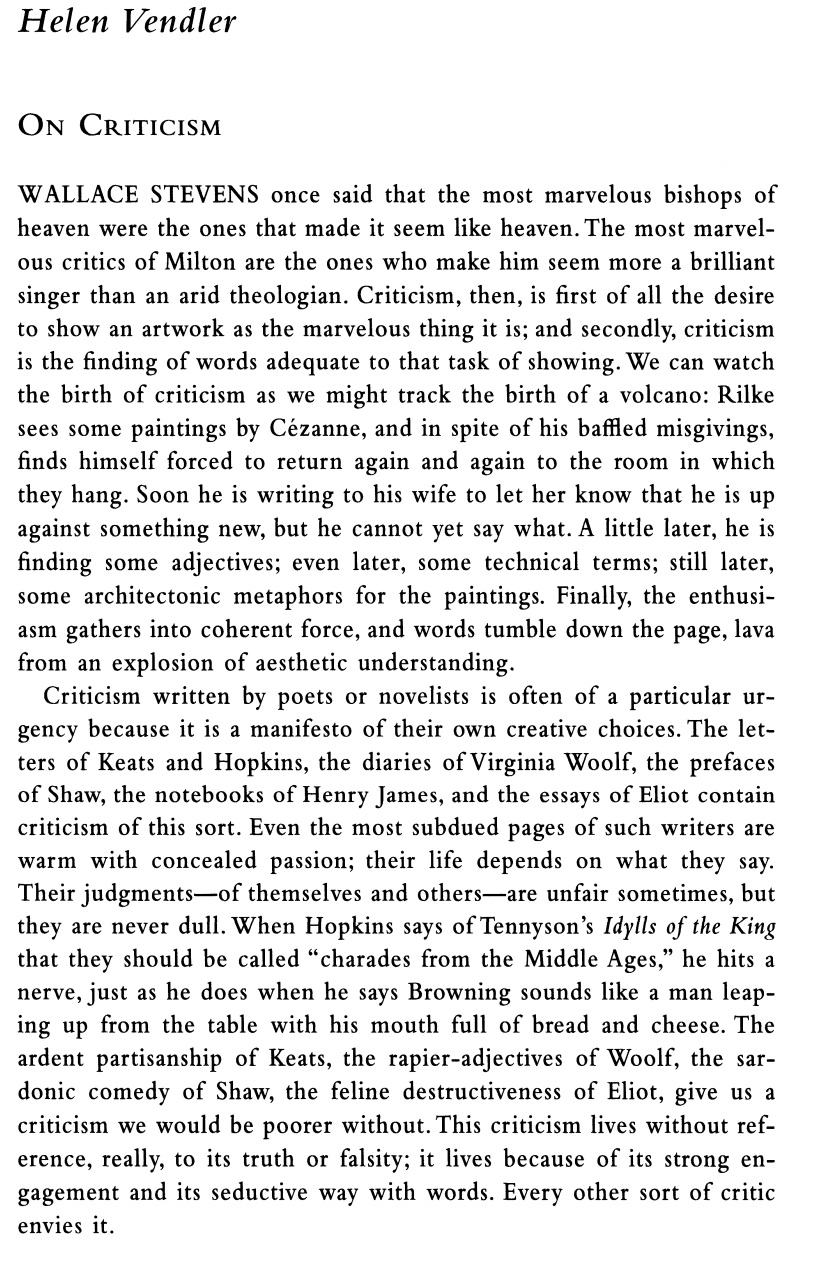 and last, J. Hoberman (extra-cool film theorist)... (click image to see/read his full review)... 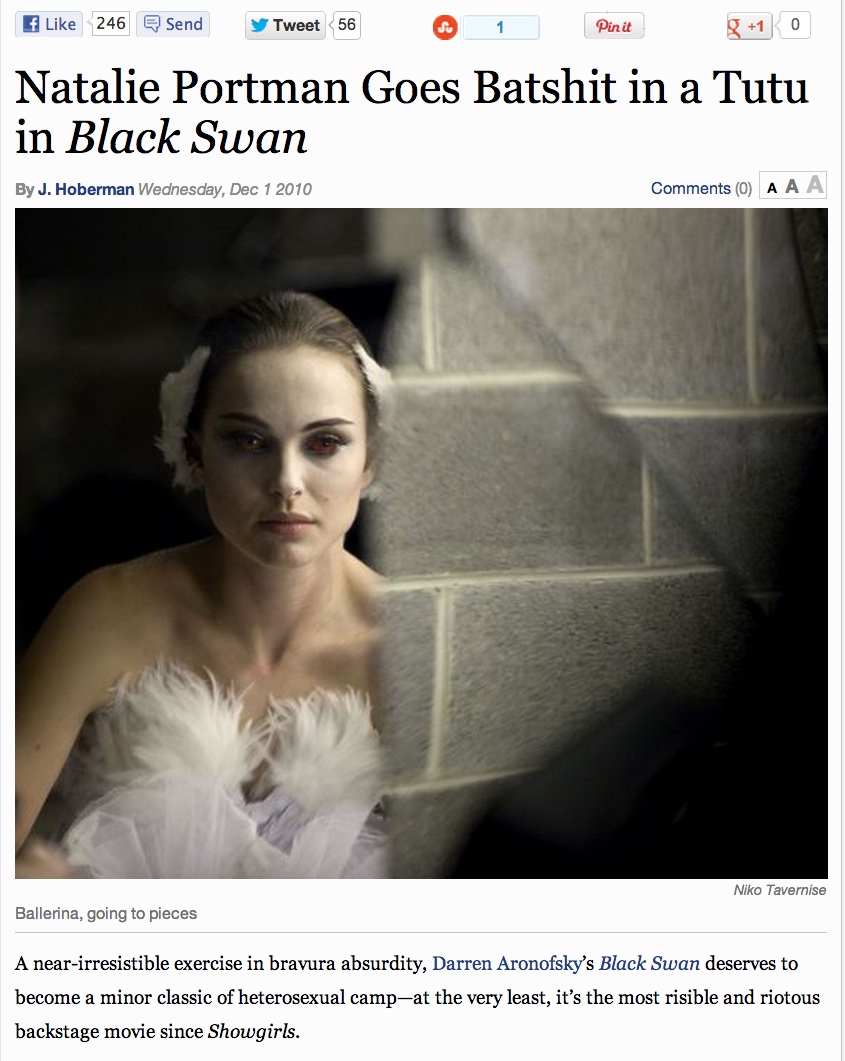 |
| urgent issues? email: memo@sdsu.edu |
| Back
to your day to day diary! |
 elcome
to "The Imagination Challenge"--your major paper
assignment for Fall 2018 in English 220: #robotic EROTIC
electric. The writing you will turn in, based on the
prompts below, should be no longer than 5 to 8 pages in
length (if you
elcome
to "The Imagination Challenge"--your major paper
assignment for Fall 2018 in English 220: #robotic EROTIC
electric. The writing you will turn in, based on the
prompts below, should be no longer than 5 to 8 pages in
length (if you 